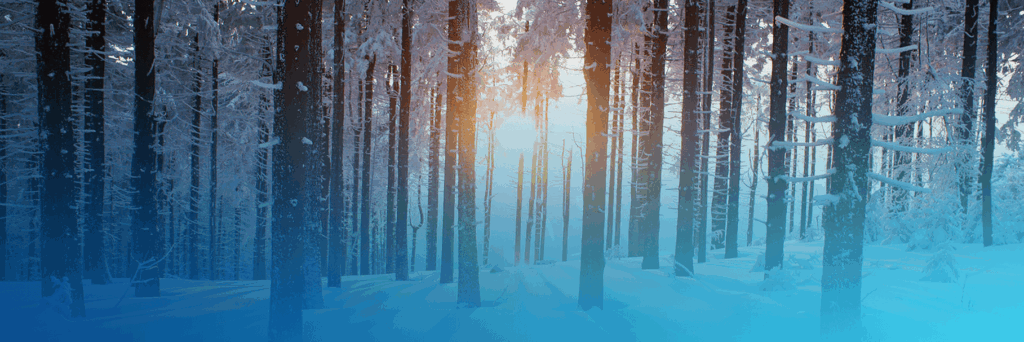

Table Of Contents
It is the coldest time of the year, with short days and long nights. Trees start to lose their leaves, animals enter deep sleep, and snow blankets everything in many places. But how much do you really know about this season? From the science behind salt melting ice to animals who know just what to wear for winter to the origins of magical traditions and festive celebrations, put your knowledge to the test on all aspects of the snowy season!
How Did Santa Claus Begin?
Santa’s image is everywhere throughout the holiday season, but do we really understand the history and origin of one of the most popular traditions? The legend of jolly old St. Nick, or Santa Claus, began with a real person: St. Nicholas. A 4th-century Christian saint, he has been credited with many miracles. He saved three officers from death in one story by appearing to Constantine in a dream. Another tale had him bringing three children back to life. St. Nicholas also developed a reputation as a great helper to the poor. One legend tells of him providing bags of gold to a poor man as dowries for his three daughters. Through such stories, St. Nicholas became associated with children and gift-giving.
Santa Claus emerged in the United States from the traditions and beliefs of a variety of cultures. The name Santa Claus is derived from Sinterklaas, a Dutch word for St. Nicholas. The color of Santa’s outfit is thought to be based on the red bishop’s robe commonly worn by St. Nicholas. In Germany and early German communities in America, tradition held that the Christkindle (Christ Child) brought gifts on Christmas Eve. Children would leave goodies for him to eat during his visit and set out straw for his mule. The word Christkindle eventually turned into Kriss Kringle, an alternative name for Santa Claus. Some of his other names include Father Christmas (Britain) and Père Nöel (France).

The current depiction of Santa Claus is based on images drawn by cartoonist Thomas Nast for Harper’s Weekly beginning in 1863. Nast’s Santa owed much to the description given in the poem “A Visit from St. Nicholas” (also known as “’Twas the Night Before Christmas”), first published in 1823. The image was further defined by the famous Santa Claus advertisements created for the Coca-Cola Company in 1931 by illustrator Haddon Sundblum. Sundblum’s Santa was a portly white-bearded gentleman dressed in a red suit with a black belt, white fur trim, black boots, and a soft red cap. Santa Claus is said to live at the North Pole with his wife, where he spends the year making toys with the help of his elves. On Christmas Eve, he loads his sleigh with toys and flies around the world, drawn by eight reindeer. Stopping at each child’s house, he slides down the chimney and leaves the gifts, refreshing himself with the milk and cookies left for him by the household’s children.
Why Do We Drop the Ball on New Year’s Eve?
“The Times Building will be especially illuminated tonight in honor of the birth of 1908,” announced The New York Times on December 31, 1907. “The exact moment of the New Year’s arrival will be signalized by dropping an electrically illuminated ball above the tower. The ball will be five feet in diameter, and light for it will be supplied by 216 electric lamps.”
That ball, powered by its 216 electric lamps, was the first of what immediately became an annual tradition! However, while New Year’s Eve celebrants still flock to Times Square in New York City to see the ball drop, only some likely know where the ritual is derived.
Times Square was already a mecca for New Year’s Eve revelers by 1904. Hundreds of thousands of people celebrated in Midtown Manhattan near the brand-new New York Times building (after which the square itself was named). At midnight, pyrotechnics were set off, making the building look like it was on fire, making for an extraordinary show. However, they also rained hot ash onto the New York City streets, a liability that worried city officials so much that fireworks became banned in 1907. Not to be deterred from putting on a fabulous show, the Times introduced a new gimmick to bring partyers to Times Square: the New Year’s Eve Ball. The first ball bore little resemblance to today’s crystal one. It weighed about 700 pounds (317 kg), was crafted out of iron and wood, and decorated with 25-watt light bulbs. Its designer was Jacob Starr, an electric sign designer, and manufacturer who supervised when, at the stroke of midnight, the ball lowered by an elaborate pulley system. Though the ball’s design changed over the years—from iron and wood to aluminum to Waterford Crystal—the tradition itself did not. With the exceptions of the World War II “dimouts” in 1942 and 1943, the New Year’s Eve Ball has not missed a year since its 1907 debut.
Why Do Some Animals Hibernate?
Certain animals hibernate because food supplies become scarce during the winter months. By going into a long deep sleep, they bypass this period completely, waking up when food becomes more plentiful. Bears are most commonly associated with hibernation (although they are not considered true hibernators because their body temperature doesn’t lower significantly), but a variety of animals take advantage of this evolved adaptation, including the jumping mouse, little brown bat, eastern chipmunk, woodchuck, and certain species of ground squirrels. At least one bird is known to be a hibernator—the poorwill, which lives in western North America. Hibernation is nothing like a regular night’s sleep, however. Significant physical changes occur within the body during the hibernation period. An animal’s body temperature plunges, and its respiration and heart rate slow dramatically. The effect can be so extreme that a hibernating animal may appear dead.

Several factors can influence hibernation. It is believed that a compound in the blood of hibernators known as HIT (Hibernation Induction Trigger) lets animals know when it is time to prepare for hibernation. Shorter days, diminishing food supplies, and colder temperatures influence HIT, though the exact mechanism remains a mystery. In regions where the winter is relatively mild, animals may hibernate for only brief periods or not at all. During long hibernation periods, many animals will rouse briefly to go to the bathroom and eat a snack before falling asleep again. Certain species of bears are unique in that they do not awaken, eat, drink, or go to the bathroom during their hibernation period, which can last several months.
Why Does Salt Melt Ice?
More than 20 million tons of salt are used yearly to melt snow and ice in cold northern regions. But how does salt do it? First, it is essential to understand H2O in the winter. Thirty-two degrees Fahrenheit (0 degrees Celsius) is its freezing point—that is, when water reaches 32 °F, it turns into ice. At this temperature, an icy road generally has a thin layer of water on top of the ice, and the ice molecules and water molecules interact. This water is constantly melting some of the ice, while the ice beneath it is freezing some of the water. At this temperature, the exchange rate is pretty constant, meaning the amount of water and ice stays the same. If it gets colder, more water becomes ice. If it gets warmer, more ice becomes water. When the ionic compound salt is added to the equation, it lowers the freezing point of the water, which means the ice on the ground cannot freeze that layer of water at 32 °F anymore. The water, however, can still melt the ice at that temperature, which results in less ice on the roads.
But you may be asking how salt lowers the freezing point of water. This concept is called “freezing point depression.” The salt makes it harder for the water molecules to bond in their rigid structure. Salt is a solute that will break into its elements in the water. So, if you’re using table salt, also known as sodium chloride (NaCl), to melt ice, the salt will dissolve into separate sodium and chloride ions. Often, however, cities use calcium chloride (CaCl2), another type of salt, on their icy streets. Calcium chloride is more effective at melting ice because it can break down into three ions instead of two: one calcium ion and two chloride ions. More ions mean more ions are getting in the way of those rigid ice bonds. Unfortunately, chloride is super bad for the environment. It can kill aquatic animals, and that can thereby affect other animal populations in their food web. Chloride also dehydrates and kills plants and can alter soil composition, making it harder for vegetation to grow. While some other compounds that can melt ice and snow do not include chloride, they are much more expensive than sodium chloride or calcium chloride.
What Animals Turn White in Winter?
As temperatures drop and autumn gives way to the seemingly ceaseless winter snows, some animals exchange their pelage or plumage of summer drab for the purest white. Unlike many animals associated with the north, such as polar bears and snowy owls, which are white all year, these creatures shift their colors with the seasons. Why this happens is not entirely clear. While camouflage is one evolutionary factor selected for seasonally white fur, the switch to winter whites also confers other advantages. Scientists believe that if staying hidden were the only upside, many more snow dwellers would be white, but that is not the case. Most Arctic animals do not change color with the seasons, even species closely related to those that do. One theory is that a pale coat may have better-insulating properties—because melanin, the substance responsible for colored hair, is absent from white fur, leaving air spaces in the hair shaft.

Several species of hares, arctic foxes, and small weasels may be the most famous examples. A subspecies of caribou native to the High Arctic of Canada and Greenland, Peary caribou, exchange their silvery summer coats for white ones with the coming of winter. The one type of bird that turns white: is the white-tailed ptarmigan. Plus, the only pet on the list, the Siberian hamster, will change from a silvery chinchilla shade to mostly white if in a room that receives natural light. Temperature does not affect the molt.

About the Author
Christopher Heintz
Customer Experience Director
Chris began his career in education as a high school social studies teacher in Chicago. Since then, he’s served in various roles in education management helping teachers navigate the complex world of assessments, data, curriculum, and instruction. Throughout it all, he’s been dedicated to one thing—providing teachers with the tools they need to create positive outcomes for the students in their care!











